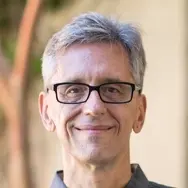China Seminar | 13 December 2012
An Introduction to the Buddhist Cave Chapels of the Ancient Kizil Kingdom
Although less well-known than their counterparts at Dunhuang, the Buddhist cave chapels of the ancient Kizil Kingdom, situated near modern Kuqa in the Xinjiang Autonomous Region, represent one of the primary resources for understanding the development of Buddhist art in Central Asia. With more than 200 surviving caves in several different sites, they provide a treasure trove of information concerning the spread of Buddhism along the Silk Road towards China, and further suggest a source of inspiration for the development of the earliest caves at Dunhuang during the 4th-6th centuries. This talk will introduce the caves, focusing on Cave 38 at the Kizil Cave site as a primary model, augmented by rare images of murals taken from the Kizil area to Germany by archeological expeditions of the early 20th century, and later destroyed in the bombing of Berlin during WWII.
Shawn Eichman is Curator of Asian Art at the Honolulu Museum of Art. He has a Bachelor of Science degree from Georgetown University, Master’s degrees from the University of Hawaii and Waseda University, and a Ph.D. in Chinese Literature from the University of Hawaii. Prior to the Honolulu Museum of Art, he worked at The Art Institute of Chicago, the Nelson-Atkins Museum, and the Virginia Museum of Fine Art. His most recent publication is Masterpieces of Landscape Painting from the Forbidden City, which accompanied the major exhibition of the same name at the Honolulu Museum of Art in 2011.
